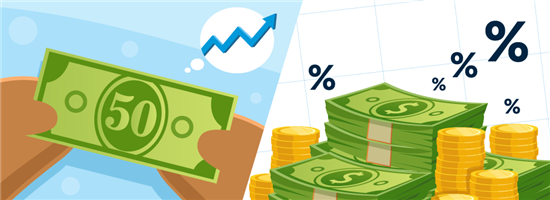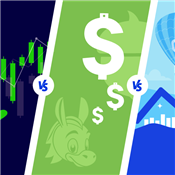How to Invest $50 Wisely
Got $50 to invest? Discover the smartest ways to grow your money—from low-risk savings accounts to stocks and cryptocurrency.
 |
Here are the best ways to invest your $50:
| Method | Risk | Difficulty |
|---|---|---|
| High-Yield Savings Accounts | Very Low | Very Easy |
| Micro-Investing Apps | Low | Very Easy |
| Optimize Your 401(k) | Low to Moderate | Easy |
| Dividend Reinvestment Plans (DRIPs) | Low to Moderate | Easy |
| Robo-Advisors | Low to Moderate | Easy |
| Exchange-Traded Funds (ETFs) | Moderate | Moderate |
| Real Estate | Moderate | Moderate |
| Peer-to-Peer Lending | Moderate to High | Moderate |
| Fractional Shares of Stock | Moderate to High | Moderate |
| Cryptocurrency | High | Hard |
| Invest in Yourself | Low | Varies |
Think $50 isn't enough to start investing? Think again. With the right strategy, even small amounts can grow significantly over time.
Choose from low-risk options for steady growth or higher-risk opportunities with greater potential rewards. There's an investment path to match every comfort level.
Keep reading to learn how to turn $50 into a stepping stone toward your financial goals.
Top Ways to Invest $50
From low-risk savings options to more aggressive strategies, here are the best ways to put your $50 to work.
Yes, you can start investing with just $50. Many platforms, like micro-investing apps, allow you to start with small amounts. It's enough to start building your portfolio and grow your money over time.
High-Yield Savings Accounts
Risk: Very Low | Difficulty: Very Easy
High-yield savings accounts are ideal for people who want a simple and safe way to store their money.
These accounts offer better interest rates than traditional savings accounts. Similarly, your money is also insured by the FDIC up to $250,000.
Potential return:
Interest rates vary depending on the market—as the economy shifts, so do potential earnings.
Generally speaking, annual percentage yields (APYs) can go as low as 0.41% (the FDIC National Average) and go as high as 4.25% APY (one of the highest rates at the time of writing, offered by Western Alliance Bank).
High Yield Savings Account - 4.25% APY
- No fees
- $1 minimum deposit
- 24/7 online access
- FDIC insured
Pros & Cons:
|
|
Micro-Investing Apps
Risk: Low | Difficulty: Very Easy
If you're new to investing, micro-investing apps make it easy to start small, build the habit of investing, and keep your risk low—all with minimal effort.
They allow you to invest tiny amounts—often spare change from purchases—into diversified portfolios of stocks and bonds.
For instance, apps like Acorns and Stash are designed to be beginner-friendly. They automatically manage your money with little to no input required.
Enter your financial goals and risk tolerance, and the app's algorithm will select and manage a diversified mix of investments tailored to your preferences.
$20 Investment Bonus
- Open an Acorns account (new users only)
- Set up the Recurring Investments feature
- Have your first investment be made successfully via the Recurring Investments feature
Potential Return:
Your average potential return for micro-investing apps depends on the chosen portfolio's risk level and market conditions. Generally:
- Conservative portfolios focus on bonds and offer lower returns but with more stability and less volatility.
- Balanced portfolios are a mix of both stocks and bonds, offering moderate growth potential while managing risk.
- Aggressive portfolios mainly invest in stocks, aiming for higher returns, but come with greater risk and volatility.
The actual performance will depend on market conditions and the specific strategies employed by the micro-investment app.
Stash, Acorns, and Robinhood are some of the best in the market. Read this comparison article to take your pick.
Pros & Cons:
|
|
Optimize Your 401(k)
Risk: Low to Moderate | Difficulty: Easy
Optimizing your 401(k) contributions is a smart choice if you're looking for a safe, long-term investment and want to take full advantage of your employer benefits.
401(k) plans are employer-sponsored retirement plans. Maximizing your contributions—especially if your employer offers a match—can be one of the easiest ways to build wealth.
While this isn't a direct investment of $50, contributing more to your 401(k) can impact your long-term financial security.
Most employers match your contributions up to a certain percentage, which is essentially free money for your retirement.
Figure out the numbers you should be aiming for with this retirement calculator.
Potential Return:
Your potential returns for this investment method will vary depending on the employer match, market performance, and how much you contribute.
Many 401(k) plans offer a mix of low-cost index funds, target-date funds, or actively managed funds, which historically can provide steady, long-term growth.
But the real advantage of optimizing your 401(k) is the employer match—typically 50% to 100% of what you invest up to a certain percentage of your salary.
Coupled with the tax-deferred growth, the compounding potential of a 401(k) can lead to significant gains over time, particularly as contributions continue to grow and reinvest.
Pros & Cons:
|
|
Dividend Reinvestment Plans (DRIPs)
Risk: Low to Moderate | Difficulty: Easy
DRIPs are an excellent, low-maintenance investment if you're focused on steady, long-term growth and like the idea of building wealth through reinvested dividends.
DRIPs let you reinvest dividends automatically into more company stock shares rather than receiving cash payouts.
Many large, stable companies offer DRIPs, and these plans allow you to continuously accumulate more shares without needing to buy stock manually. With $50, you can start small and watch your investment grow as dividends are reinvested over time.
Get an idea of how much you can potentially earn from your investments through this compound interest calculator.
Potential Return:
Potential returns from DRIPs come from two main sources: stock price appreciation and dividend payments. If the underlying stock performs and continues to grow, the value of your investment will grow over time.
As dividends are reinvested, the compounding effect can lead to increased share accumulation, which produces even more dividends in the future.
Over the long term, DRIPs can provide steady, reliable growth, especially with companies that pay consistent dividends.
Returns are lower if a company's stock performs poorly or reduces its dividends.
Pros & Cons:
|
|
Robo-Advisors
Risk: Low to Moderate | Difficulty: Easy
Robo-advisors are best for those who want easy, diversified investing and are willing to accept some market risk in exchange for better potential returns than a savings account.
Robo-advisors like Betterment or Wealthfront automate the investment process by creating and managing a diversified portfolio based on your risk tolerance and financial goals.
With just $50, they'll allocate your money across a mix of stocks and bonds, balancing your portfolio as markets fluctuate.
Potential Return:
Like micro-investing apps, your potential returns with robo-advisors depend on your risk level.
Conservative portfolios typically grow slower but are stable, while more aggressive ones have higher potential but come with increased risk.
Pros & Cons:
|
|
Exchange-Traded Funds (ETFs)
Risk: Moderate | Difficulty: Moderate
If you want to diversify your investment and are willing to take on a little market risk, ETFs provide an affordable way to invest broadly in stocks or bonds.
An exchange-traded fund (ETF) is a collection of stocks or bonds traded on the stock market. It allows you to diversify your $50 across many companies with a single investment.
If it fits what you're looking for, you can purchase ETFs through platforms like Robinhood or Fidelity.
Potential Return:
With ETFs, you have moderate growth potential due to the diversification across different stocks or bonds.
Returns will vary depending on market performance but tend to be higher than basic savings options over the long term.
Pros & Cons:
|
|
Yes, even with just $50, diversification is important. Using ETFs or robo-advisors can help spread your money across different assets, reducing risk and improving your chances of steady growth.
Real Estate
Risk: Moderate | Difficulty: Moderate
Real estate investment trusts (REITs) are great for investors who want real estate exposure without the need for a large upfront investment or the management of physical properties.
With $50, you can invest in REITs, which own, operate, or finance real estate that produces income. These trusts are traded like stocks and typically offer dividends, making them a great way to diversify your investments and gain exposure to real estate without needing to buy property yourself.
Alternatively, you can try real estate crowdfunding. This lets you pool money with other investors to fund properties together. You earn returns from the rents collected and when the property appreciates in value.
Invest in Real Estate with $10+
- Only $10 minimum investment
- Get a diversified portfolio of real estate projects across the US
- Open to all investors
Potential Return:
Historically, REITs have delivered competitive returns, often outpacing inflation and providing a balance of income and growth.
However, like any investment tied to the market, REITs can fluctuate with economic conditions, and their value may decrease if real estate prices fall or if the REIT's management underperforms.
Pros & Cons:
|
|
Peer-to-Peer Lending
Risk: Moderate to High | Difficulty: Moderate
Peer-to-peer lending is worth considering if you're comfortable with moderate risk and want to earn higher returns while potentially supporting small borrowers.
Platforms like Prosper allow you to lend money directly to individuals or small businesses in exchange for interest.
With just $50, you can split your investment into smaller loans, thus spreading your risk across multiple borrowers.
Potential Return:
Potential returns with peer-to-peer lending can be higher than traditional investments, often ranging from 5% to 10% or more.[1][2]. It depends on the borrowers' creditworthiness.
There's potential for solid growth if loans are repaid. But there's always a chance the borrower won't repay the loan, so you could lose part or all of your investment.
Pros & Cons:
|
|
Fractional Shares of Stock
Risk: Moderate to High | Difficulty: Moderate
If you want to invest in individual companies and are willing to do some research, fractional shares are a great way to get exposure to top-tier stocks with just $50.
With fractional shares, you can buy a portion of a stock. So you can own high-priced stocks like Amazon or Google with just $50.
Check out Robinhood or Webull to purchase fractional shares.
20 Free Fractional Shares
Open a new Webull individual brokerage account. Make a qualifying single initial deposit of $500 or more during the promotional period to get 20 fractional shares, each valued between $3 - $3,000. Maintain a balance of $500 or more in the account for 30 days or more. Terms and conditions apply.
Potential Return:
Historically, the S&P has delivered an annual return of 7-10%[3] over the long term. But this ultimately depends on the stock market's performance.
Blue-chip stocks typically provide stable, long-term growth, while more speculative stocks
could offer higher returns with more risk.
Pros & Cons:
|
|
Cryptocurrency
Risk: High | Difficulty: High
Cryptocurrency offers the chance for high returns, but it isn't for the faint of heart. It's a great investment if you're comfortable with extreme risk and want to try something speculative.
Cryptocurrency such as Bitcoin and Ethereum is one of the riskiest but most potentially rewarding ways to invest $50. Platforms like Coinbase or Binance let you buy fractional amounts of these digital currencies, allowing you to get started with even small sums.
Potential Return:
Highly volatile with potential for significant gains but also substantial losses. Returns can vary widely based on market trends and investor sentiment.
Pros & Cons:
|
|
Invest in Yourself
Risk: Low | Difficulty: Varies
If you're interested in long-term personal growth or career advancement, investing in yourself is one of the smartest decisions you can make with $50.
With $50, you can buy books, take online courses, or earn certifications that will help improve your skills or career prospects.
Websites like Udemy or Coursera offer a wide range of affordable courses in marketing, coding, personal finance, and more.
Potential Return:
Investing in yourself offers the most flexible and potentially unlimited return among all options. The return you can expect depends mainly on the skills you acquire, how you apply them, and their impact on your personal or professional growth.
The key benefit of investing in yourself is that the return compounds over time. Skills, knowledge, and personal development do not depreciate like material investments. They continue to pay dividends throughout your life, influencing your career, financial decisions, and personal satisfaction.
While the return may not be immediate, this is one of the few investments where the ceiling is limitless. The more you apply what you learn, the more significant the return—whether that's in increased income, business success, or personal growth.
Pros & Cons:
|
|
Why Start Investing With $50?
Thanks to compounding, even small investments like $50 can grow significantly over time. What's more, starting early builds the habit of investing and allows your money to work for you.
Many platforms let you start with minimal amounts, so there's no need to wait until you have more money. The key is to start now and be consistent.
How long does it take to see returns from investing $50?
The timeline for seeing returns on your $50 investment varies greatly depending on the type of investment. For example:
- Stocks and ETFs
These typically require a longer horizon to see significant growth. While you might notice some changes in value over weeks or months, meaningful returns usually occur over several years. - Peer-to-peer lending
Returns can be realized sooner, often in the form of regular investment payments, but the risk of default can delay or diminish your profits. - Cryptocurrency
While there's potential for rapid gains, the extreme volatility means you could see sharp losses just as quickly. - High-yield savings accounts or CDs
These are low-risk options where returns are steady and slower, with gains largely dependent on interest rates and compounding over time.
Investment Calculator
If you're curious about how much you can earn with your $50 investment, this tool will allow you to input all the details of your investment and give you a clearer picture of your potential growth.
Here's how to use the calculator:
- Enter your initial investment.
- Input how much you plan to contribute per month.
- Specify how long you're growing your investment.
- Enter the interest rate.
- Define the compound frequency.
From there, click "Calculate." You'll see your end balance, total interest earned, and the total contribution amount.
Yes, most platforms allow you to continue adding money to your investments over time. Consistently contributing small amounts, even just $10 or $20, can significantly grow your investment through compounding.
Small Investment Mistakes to Avoid
Avoiding common mistakes is essential when investing small amounts. Minor errors can impact your overall returns.
Here are the common mistakes you should never do:
- Ignoring platform fees
Ignoring fees is one of the biggest pitfalls of investors. High fees can quickly erode small investments, so choose platforms that offer low or no fees. - Chasing quick returns
Because some people want quick returns, they make the mistake of investing in risky assets like penny stocks. Instead, you should focus on steady, long-term investments that provide more consistent growth. - Lack of diversification
Spreading your $50 across multiple assets can help reduce risk and protect your investment, especially if you plan to add more overtime. - Expecting quick profits
Similar to chasing quick returns, you'll want to avoid expecting quick profits. Small investments take time to grow. Patience is critical, and focusing on long-term gains yield better results. - Not investing regularly
This can limit your progress. A single $50 investment isn't enough to build wealth. So regular, consistent contributions are necessary to see meaningful growth over time.
Be mindful of fees such as management fees for robo-advisors, monthly fees for micro-investing apps, and trading fees for stock purchases. High fees can cut returns on small investments, so choosing a low-cost platform is essential.
How to Choose the Right Investment
Choosing the right investment depends on your personal financial situation, goals, and risk tolerance.
There's no one-size-fits-all answer, but here are a few key questions to ask yourself when deciding where to invest your $50.
- What's your risk tolerance?
Are you comfortable with market fluctuations, or would you rather keep your money in a safe, lower-return option? Understanding how much risk you can handle will help you narrow your choices. - What's your time horizon?
How long do you plan to leave your money invested? If you're investing for a long-term goal like retirement, you can afford to take on more risk with stocks and real estate.If you need quicker access to your funds, peer-to-peer lending or low-risk savings options might be better for the short-term.
- What are your financial goals?
Are you looking to grow your money for retirement, save for a big purchase, or just learn about investing? Your goals will help determine the best investment strategy.For example, stocks, ETFs, DRIPs, and 401(k) contributions are geared towards long-term growth, while REITs and dividend-paying stocks can provide regular income.
- Do you want to be hands-on or hands-off?
If you prefer to take an active role, an investment method like buying individual stocks might be the way to go. If you're looking for a more passive option, robo-advisors or DRIPs automatically manage and reinvest your funds for you.
Methodology
The investment options in this article were selected based on accessibility, ease of entry, and potential for long-term growth.
We considered a range of factors, like risk level, difficulty for beginners, and potential returns. This ensures that low-risk, conservative options and higher-risk, growth-oriented strategies were included.
That said, each method was evaluated for its suitability for new investors. So we focused on platforms and strategies widely available, easy to understand, and commonly used by individuals starting with small sums of money.
Bottom Line
Investing $50 can seem like a small step, but each option on this list has the potential to grow your money over time.
Choose the option that best fits your financial goals, risk tolerance, and knowledge level. Remember, consistency is key to building long-term wealth.
References
- ^ Prosper. Invest in loans, Retrieved 02/27/2025
- ^ ScienceDirect. What if borrowers stop paying their loans? Investors' rates of return on a peer-to-peer lending platform, Retrieved 02/27/2025
- ^ Backtest by Curvo. Historical performance of the S&P 500 index, Retrieved 04/10/2025
Iggi Vargas is a research analyst at CreditDonkey, a personal finance comparison and reviews website. Write to Iggi Vargas at iggi.vargas@creditdonkey.com. Follow us on Twitter and Facebook for our latest posts.
Note: This website is made possible through financial relationships with some of the products and services mentioned on this site. We may receive compensation if you shop through links in our content. You do not have to use our links, but you help support CreditDonkey if you do.
Fundrise, LLC ("Fundrise") compensates CreditDonkey Inc for new leads. CreditDonkey Inc is not an investment client of Fundrise.
|
|
| ||||||
|
|
|













